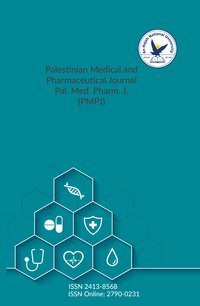Factors associated with birth weight patterns in northern west bank
Authors:
Article info
2020-07-12
2021-03-03
57 - 66
Keywords
- Weight gain
- newborn
- large birth weight
- Low birth weight
Abstract
Infants with low birth weight (LBW) < 2.5 Kg and large gestational weight (LGA) > 4 Kg are conditions that are linked to infant mortality and future decline in wellbeing. This study aimed to evaluate factors that are associated with both LBW and LGA among a group of pregnant women in Nablus in the northern West Bank. The study involved 387 pregnant women who were recruited from Palestinian Ministry of Health outpatient clinics during 2017-2018. Data were collected using a self-administered questionnaire that included questions about demographic data and birth outcomes. Data regarding anthropometric height and weight to calculate the body mass index (BMI) and weight gain during each trimester were collected from the women files. Data was analyzed by SPSS.15.3% and 9.7% of the newborns were LBW and LGA, respectively. Both anemia and smoking increased the risk of having LBW (p< 0.05). Parity, gravidity, and diet were all related to LBW risk. Younger age and diet protected from having LGA infants (p< 0.001). LBW and LGA are common in Northern West Bank region of Nablus. Health education could help decrease the risk.
Natour, N., AL-Tell, M., & AL-Rob, A. A. (2022). Factors associated with birth weight patterns in northern west bank. Palestinian Medical and Pharmaceutical Journal, 7(1), 57–66. https://doi.org/10.59049/2790-0231.1046
[1]N. Natour, M. AL-Tell, and A. A. AL-Rob, “Factors associated with birth weight patterns in northern west bank,” Palestinian Medical and Pharmaceutical Journal, vol. 7, no. 1, pp. 57–66, Jun. 2022, doi: 10.59049/2790-0231.1046.
Natour, Nihal, et al. “Factors Associated with Birth Weight Patterns in Northern West Bank.” Palestinian Medical and Pharmaceutical Journal, vol. 7, no. 1, June 2022, pp. 57–66. Crossref, https://doi.org/10.59049/2790-0231.1046.
1.Natour N, AL-Tell M, AL-Rob AA. Factors associated with birth weight patterns in northern west bank. Palestinian Medical and Pharmaceutical Journal [Internet]. 2022 Jun;7(1):57–66. Available from: http://dx.doi.org/10.59049/2790-0231.1046
Natour, Nihal, Mariam AL-Tell, and Arwa Abo AL-Rob. “Factors Associated with Birth Weight Patterns in Northern West Bank.” Palestinian Medical and Pharmaceutical Journal 7, no. 1 (June 2022): 57–66. https://doi.org/10.59049/2790-0231.1046.
Factors associated with birth weight patterns in northern west bank
المؤلفون:
معلومات المقال
2020-07-12
2021-03-03
57 - 66
الكلمات الإفتتاحية
- Weight gain
- newborn
- large birth weight
- Low birth weight
الملخص
Infants with low birth weight (LBW) < 2.5 Kg and large gestational weight (LGA) > 4 Kg are conditions that are linked to infant mortality and future decline in wellbeing. This study aimed to evaluate factors that are associated with both LBW and LGA among a group of pregnant women in Nablus in the northern West Bank. The study involved 387 pregnant women who were recruited from Palestinian Ministry of Health outpatient clinics during 2017-2018. Data were collected using a self-administered questionnaire that included questions about demographic data and birth outcomes. Data regarding anthropometric height and weight to calculate the body mass index (BMI) and weight gain during each trimester were collected from the women files. Data was analyzed by SPSS.15.3% and 9.7% of the newborns were LBW and LGA, respectively. Both anemia and smoking increased the risk of having LBW (p< 0.05). Parity, gravidity, and diet were all related to LBW risk. Younger age and diet protected from having LGA infants (p< 0.001). LBW and LGA are common in Northern West Bank region of Nablus. Health education could help decrease the risk.
Natour, N., AL-Tell, M., & AL-Rob, A. A. (2022). Factors associated with birth weight patterns in northern west bank. Palestinian Medical and Pharmaceutical Journal, 7(1), 57–66. https://doi.org/10.59049/2790-0231.1046
[1]N. Natour, M. AL-Tell, and A. A. AL-Rob, “Factors associated with birth weight patterns in northern west bank,” Palestinian Medical and Pharmaceutical Journal, vol. 7, no. 1, pp. 57–66, Jun. 2022, doi: 10.59049/2790-0231.1046.
Natour, Nihal, et al. “Factors Associated with Birth Weight Patterns in Northern West Bank.” Palestinian Medical and Pharmaceutical Journal, vol. 7, no. 1, June 2022, pp. 57–66. Crossref, https://doi.org/10.59049/2790-0231.1046.
1.Natour N, AL-Tell M, AL-Rob AA. Factors associated with birth weight patterns in northern west bank. Palestinian Medical and Pharmaceutical Journal [Internet]. 2022 Jun;7(1):57–66. Available from: http://dx.doi.org/10.59049/2790-0231.1046
Natour, Nihal, Mariam AL-Tell, and Arwa Abo AL-Rob. “Factors Associated with Birth Weight Patterns in Northern West Bank.” Palestinian Medical and Pharmaceutical Journal 7, no. 1 (June 2022): 57–66. https://doi.org/10.59049/2790-0231.1046.

Since 2022
Cite Score (Scopus): 0.8
Time to First Decision: 3 Days
Submission to Acceptance: 45 Days
Acceptance to Publication: 64 Days
Acceptance Rate: 17%
Why should you
Publish With Us?
An-Najah National University
Nablus, Palestine
Nablus, Palestine
- P.O. Box
- 7, 707
- Fax
- (970)(9)2345982
- Tel.
- (970)(9)2345560
- (970)(9)2345113/5/6/7-Ext. 2628
- [email protected]
- EIC
- Prof. Waleed Sweileh
The Palestinian Medical and Pharmaceutical Journal (Pal. Med. Pharm. J.) © 2024 by An-Najah University, Nablus, Palestine is licensed under CC BY-NC 4.0
News and Views
